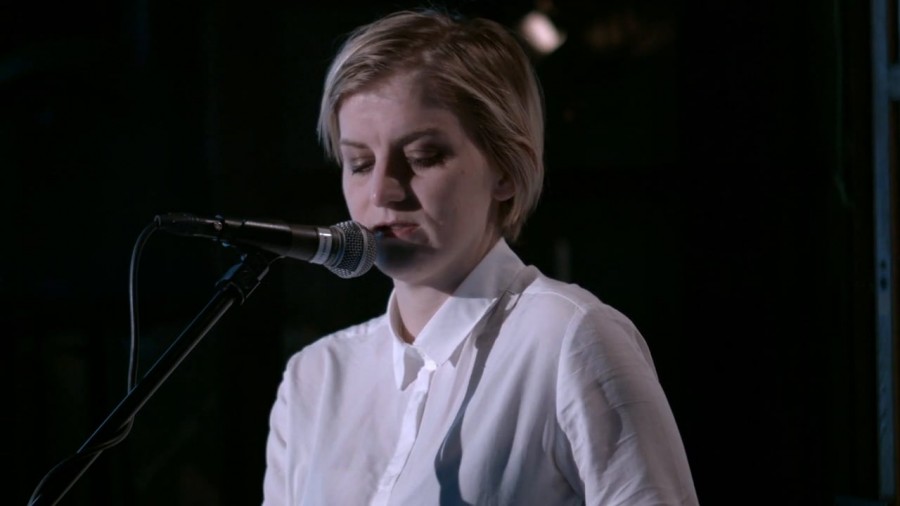Allison Burtch: Hi, everyone. My name is Allison Burtch and I am currently a resident at the Eyebeam Art & Technology Center in Brooklyn, New York and teaching at the School for Poetic Computation, which I’ll tell you a little bit about my class. And I’m very happy to be here, so thank you Golan and Addie and the Studio.
I’m going to talk a little bit about some projects that I made and also sort of general thoughts about making technology in the world we live in today. So I’m going to read this quote:
What is going on? Of what are we the half-fascinated half-devastated witnesses? The continuation at all costs, of a weary world? A salutary crisis of that world, racked by its victorious expansion? The end of that world? The advent of a different world? What is happening to us in the early years of the century – something that would appear not to have any clear name in any accepted language?
The Rebirth of History, Alain Badiou
This is the first paragraph in Alain Badiou’s The Rebirth of History and I like that someone can start a book off by saying “What is going on?” because I feel like it’s a good question and I think a lot of the other two talks were fairly melancholy as well because we’re in a very difficult place in history. And it’s up to us to work together to move that tide differently.
So what was the goal of computers, or the Internet, this whole vision that we’ve heard I’m sure about how the Internet will change everything and it has. The beauty of the Internet and connected devices is this idea of a self-stabilizing, inclusive, democratic, peer-to-peer distributed network where we’re free to pursue our own happiness. The be this Randian individual. And the underlying idea is that if only we were able to hear more about people, somehow that will make the world a better place. And I feel like that has, and we can see especially with the protests going on right now. I feel like a lot of people have been radicalized by what they’re seeing on Tumblr, Twitter, and moved to change.
Yet at the same time what we also see is that the global influx of telecommunications technology has resulted in an enormous consolidation of wealth and power. And so we’re at this impasse where we’re making technology in this realm where the people who are making money off of it are making a lot of money. I’m sure we all know that. There’s a massive consolidation of wealth and power at the top. In 2010, 93% of the additional income created in American went to the top 1%. And we’re seeing that in the rest of the world.

Jean-François Millet, The Gleaners
What I’d like to propose is that what we see is that the majority of the world’s people, when it comes to technology are actually these gleaners. It’s a Biblical term, and it’s the act of collecting leftover crops from farmer’s fields after they have been commercially harvested, or on fields where it is not economically profitable to harvest. And so as a technologist I want to know how can I make stuff for the people in this realm. And really how do we make stuff in this world where we see so many things that are messed up.
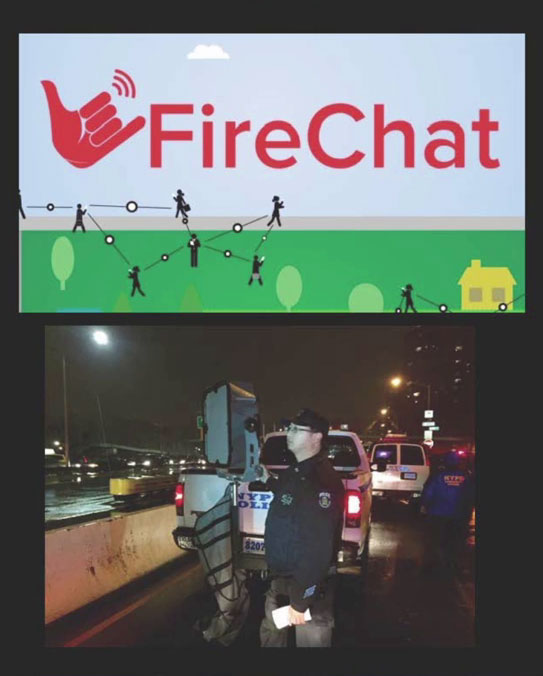 So in this past year I came up with this idea of “liberation technology” which I’ll talk about in a second. But first I want to show you this. Here we see two different examples of technology used in protest. Does anyone know what the thing at the bottom is? It’s called an LRAD, a Long Range Acoustic Device. And then the top is FireChat, which is this Bluetooth-enabled peer-to-peer chatting mechanism that the protesters in Hong Kong used. So technologists, especially at a place like CMU are faced with the reality that either we cannot control the technology that we create, or oftentimes when we start making stuff we don’t think about the parameters about which the technology can be used. I mean I’m sure there are some people who are really stoked to make an LRAD, but that’s not me.
So in this past year I came up with this idea of “liberation technology” which I’ll talk about in a second. But first I want to show you this. Here we see two different examples of technology used in protest. Does anyone know what the thing at the bottom is? It’s called an LRAD, a Long Range Acoustic Device. And then the top is FireChat, which is this Bluetooth-enabled peer-to-peer chatting mechanism that the protesters in Hong Kong used. So technologists, especially at a place like CMU are faced with the reality that either we cannot control the technology that we create, or oftentimes when we start making stuff we don’t think about the parameters about which the technology can be used. I mean I’m sure there are some people who are really stoked to make an LRAD, but that’s not me.
That brings me to this class that I taught at SFPC which is called “Critical Theory of Technology.” What I would like to say is that discussions about technology are actually rarely about technology, they’re about humans, money, and power. And so when you get artists together who make tech stuff, it’s so easy to start talking about, “Oh like, what [inaudible] do? How can you add this to this to make this?” and it becomes all about this technology instead of about humans, and so the goal for this class is really “What’s going on in this world? Who are humans, and what do we need?” So within this tremendous misery and injustice in the world, how can we deal with it, and then also how do we pay the rent? My goal for the class was to live in that tension, to empower makers, musicians, coders, and artists to continue to make wide-eyed and yet still open-hearted— One of my favorite authors, Ursula K. LeGuin calls this “the Grand Inquisitor’s Choice,” where you choose freedom without happiness, or happiness without freedom. The only answer one can make, I think: no. And so with contemporary society and our collective future irrevocably changed by this ubiquitous technology, the questions that makers, artists, and technologists pose to society are increasingly relevant.
So, liberation technology. I would like to define this by saying that it’s technology that exists to liberate people from unjust economic, political, or social conditions. I am really interested in being really clear about what that end result is, and what the actual politics you’re looking for… We can toss around these ideas of democracy, liber—stuff like that, but what does that actually look like, and that’s not something for this talk. But we can talk afterwards. So now I’ll discuss a couple of projects that I made and how I think they fit into this parameter of liberation technology.
The Dumb Store is an open-source mobile app platform for dumbphones. Hardware is constantly changing and companies profit from planned obsolescence, which disproportionately affects the poor. However I don’t think that people need to keep buying things in order to access information, and so the Dumb Store is a software platform that allows people to access information that’s normally accessed through smartphones. It was developed in collaboration with Ramsey Nasser and built primarily at Eyebeam in 2013, and now my buddy David Huerta is also working on it. You can text 646−666−3536 “apps” or “info” or “haiku” and it’ll give you back some information.
Another thing I made is a thing called Spyke, which don’t even try to use this, it’s terrible and doesn’t work, but I tried so I’ll talk a little bit about it. Privacy I would say is a means to democracy, it’s not an end in itself. And I also think that when we enter into a world where all of our communications have to be private, something has gone wrong. There’s something that’s actually really important about having a society where people can be leaders or can have a public voice. But I think with the decentralization of the Internet what we’re starting to see, and with COINTELPRO and all these different things, is that people are protecting themselves from essentially being decapitated by not having leaders. Spyke is an in-browser video chat that uses WebRTC, so you can just send someone a link and chat in the browser.
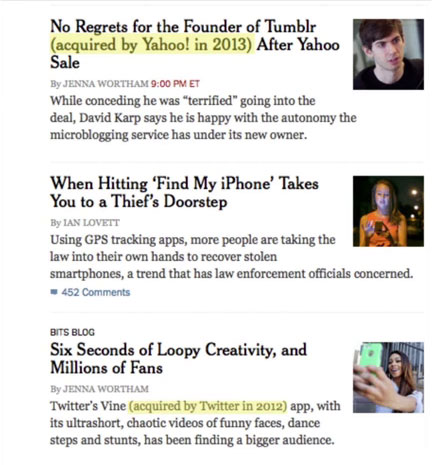 Another project that I made is a Firefox addon called the Internet Illuminator. On the Internet we have access to so much information, so many names, corporations, etc. But oftentimes, the real truth or the real connections are being withheld. So this addon iterates through all the HTML text in your browser and whenever it finds a person or corporation from the data, it illuminates that relationship a little bit. It uses LittleSis data, which is a non-profit called “Facebook for the 1%” so it has a bunch of data sets and it shows how they’re connected. I focused on things like tech acquisitions, so the thing in yellow is what you’ll see appended and it just works in HTML text, and that’s from the New York Times so it works in whatever. Another tech acquisition or products. That shows you who they’re owned by.
Another project that I made is a Firefox addon called the Internet Illuminator. On the Internet we have access to so much information, so many names, corporations, etc. But oftentimes, the real truth or the real connections are being withheld. So this addon iterates through all the HTML text in your browser and whenever it finds a person or corporation from the data, it illuminates that relationship a little bit. It uses LittleSis data, which is a non-profit called “Facebook for the 1%” so it has a bunch of data sets and it shows how they’re connected. I focused on things like tech acquisitions, so the thing in yellow is what you’ll see appended and it just works in HTML text, and that’s from the New York Times so it works in whatever. Another tech acquisition or products. That shows you who they’re owned by.
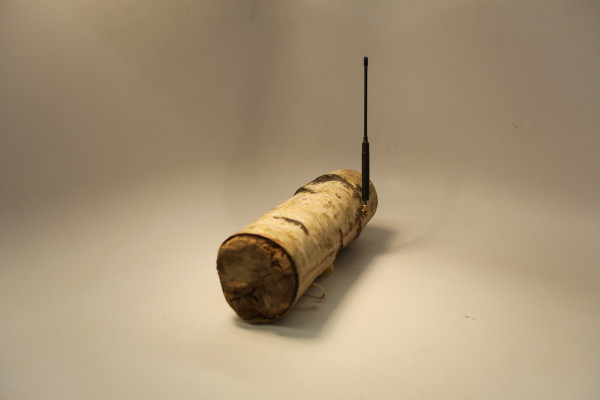 Another project I made that I would put within the context of liberation technologies, safe spaces, and the need to constantly communicate is this next one I’ll talk about. The problem is no longer getting people to express themselves, but providing any miniscule gap of solitude in which they might eventually find something to say. This brings me to the physical world and how we’re interacting in the present. Who cares if you have a bunch of information if you can’t deal with it, if you can’t talk to each other. So I made a log jammer. The log jammer provides a safe space in the woods in nature, a right to be alone. What a relief to have the right to say nothing, because only then is there a chance of framing the rare, the thing that might be worth saying. And the log jammer is a cell phone jammer in a log. And just like cell phone towers are disguised as fake trees, I made a real tree in real woods and put a cell phone jammer in it.
Another project I made that I would put within the context of liberation technologies, safe spaces, and the need to constantly communicate is this next one I’ll talk about. The problem is no longer getting people to express themselves, but providing any miniscule gap of solitude in which they might eventually find something to say. This brings me to the physical world and how we’re interacting in the present. Who cares if you have a bunch of information if you can’t deal with it, if you can’t talk to each other. So I made a log jammer. The log jammer provides a safe space in the woods in nature, a right to be alone. What a relief to have the right to say nothing, because only then is there a chance of framing the rare, the thing that might be worth saying. And the log jammer is a cell phone jammer in a log. And just like cell phone towers are disguised as fake trees, I made a real tree in real woods and put a cell phone jammer in it.
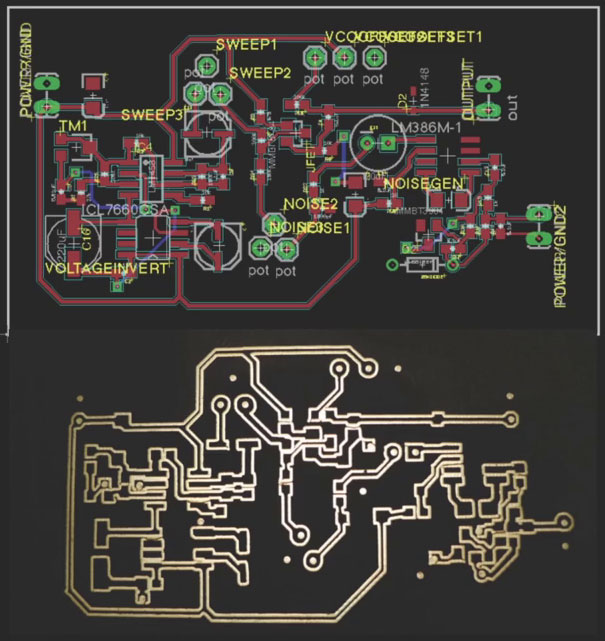 I’ll go into it very briefly. This screenshot’s from Eagle. The top is a screenshot, the bottom is an actual milled circuit. This is actually just GSM-1900; it’s what my phone operated on. I found this schematic online and went through dozens of iterations. It’s all open-source. I also want to say that it’s illegal, so I didn’t actually mess with people. I’m really interested in making consensual things, not messing with people. But I did make it and it did work. I milled and drilled the PCB and created a stencil for solder paste, and then made it, etc.
I’ll go into it very briefly. This screenshot’s from Eagle. The top is a screenshot, the bottom is an actual milled circuit. This is actually just GSM-1900; it’s what my phone operated on. I found this schematic online and went through dozens of iterations. It’s all open-source. I also want to say that it’s illegal, so I didn’t actually mess with people. I’m really interested in making consensual things, not messing with people. But I did make it and it did work. I milled and drilled the PCB and created a stencil for solder paste, and then made it, etc.
 My current project right now, I wish I had some better documentation for this but it’ll have to do. It’s going to be released at the end of January. We know through the Snowden revelations that the NSA can basically just tap into your phone microphones and just turn them on at will. And then also corporations can buy time from apps who have access to your microphone. So many apps just randomly want your microphone. So what I wanted to make is a separate hardware project that would ambiently block that microphone and that wouldn’t be used to mess with people, so it’s not going to work across the room. It’s going to be placed directly next to your phone. What it does is it creates noise at around 24kHz. That essentially overwhelms the mic so that you just hear white noise when you press play, but it’s inaudible. So that’s what I’m working on right now.
My current project right now, I wish I had some better documentation for this but it’ll have to do. It’s going to be released at the end of January. We know through the Snowden revelations that the NSA can basically just tap into your phone microphones and just turn them on at will. And then also corporations can buy time from apps who have access to your microphone. So many apps just randomly want your microphone. So what I wanted to make is a separate hardware project that would ambiently block that microphone and that wouldn’t be used to mess with people, so it’s not going to work across the room. It’s going to be placed directly next to your phone. What it does is it creates noise at around 24kHz. That essentially overwhelms the mic so that you just hear white noise when you press play, but it’s inaudible. So that’s what I’m working on right now.
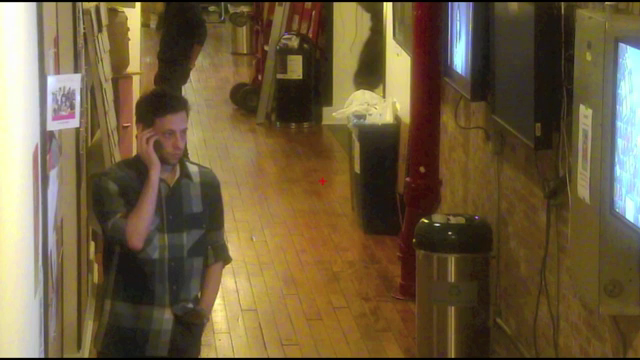 In this project I took over 10,000 surveillance pictures of myself and a classmate back at NYU using Processing, an open-source programming language. I wanted to tell a story that highlighted our interaction or lack thereof, and basically what can you tell from surveillance when everyone says, “Oh well I have nothing to hide.” What can you make out of nothing, basically. And is a story still a story if it’s told through surveillance cameras which are “the truth.” But I also wanted to comment on this idea that I call “cop art.” Cop art is a form of surveillance art where you just mimic the oppressor, and I feel like I see it a lot with people who make surveillance art where it’s just like, “Hey I stalked someone and called it art.” and it’s like no, you’re being a cop. You’re literally copying the NSA, you’re not making art. So I created this sort of transaction where I put my body and all of my emotions as a gift to the audience. I’ll show it to you.
In this project I took over 10,000 surveillance pictures of myself and a classmate back at NYU using Processing, an open-source programming language. I wanted to tell a story that highlighted our interaction or lack thereof, and basically what can you tell from surveillance when everyone says, “Oh well I have nothing to hide.” What can you make out of nothing, basically. And is a story still a story if it’s told through surveillance cameras which are “the truth.” But I also wanted to comment on this idea that I call “cop art.” Cop art is a form of surveillance art where you just mimic the oppressor, and I feel like I see it a lot with people who make surveillance art where it’s just like, “Hey I stalked someone and called it art.” and it’s like no, you’re being a cop. You’re literally copying the NSA, you’re not making art. So I created this sort of transaction where I put my body and all of my emotions as a gift to the audience. I’ll show it to you.
When I showed that at the ITP show I actually put a surveillance camera on people as they were watching it, and I traded their data back to them. So if they wrote an honest emotion on their picture, then I would delete their picture from my computer and it would be on the wall. I was actually really surprised at how vulnerable people were. It was kind of an incredible moment in a space where so many people were trying to sell apps.
So liberation technology, technology that exists to liberate people from unjust economic, political, or social conditions. So what is our common horizon? I just want to end with this. Discussions about technology are rarely actually about technology. They’re about humans, money, and power. And as a framework for thinking about what you’re looking at, just some questions to bring up:
Do you understand the political end to this art? Does it glorify the individual? Does it focus on individual rights, or collective rights? Does it bring people together, or does it fragment them? Those are some things that I’m thinking about in regards to what to make and analyzing what other people make. And I’m really excited for this week. So thank you everyone for listening, and if you want to contact me you can hit me up on Twitter or email me or afterwards, etc. That’s it.
